Typhoon Haiyan: Hundreds feared dead in Philippines
- Published
Richard Gordon, Chairman, Red Cross Philippines: "There are many, many dead bodies"
Hundreds of people are feared dead in the Philippines after Typhoon Haiyan swept through on Friday.
Among the worst hit areas were the eastern island of Leyte and the coastal city of Tacloban, which saw buildings flattened in a storm surge.
First reports said 100 bodies had been found there but the Red Cross later estimated a figure of more than 1,000, with 200 more deaths in Samar province.
Hundreds of thousands of people are reported displaced from their homes.
President Benigno Aquino said he feared there would be "substantially more casualties".
Defence Secretary Voltaire Gazmin said: "All systems are down. There is no power, no water, nothing. People are desperate. They're looting."
Typhoon Haiyan - one of the most powerful storms on record to make landfall - is now bearing down on Vietnam, where tens of thousands are being evacuated.
The BBC Weather Centre says the typhoon is expected to make landfall south of Hanoi on Monday afternoon local time (between 03:00 and 09:00 GMT), although it will have decreased markedly in strength.
Storm surge
The latest report, external from the Philippines' Disaster Risk Reduction and Management Council confirmed 138 deaths as of 10:00 GMT on Saturday. It said almost 350,000 people had been reported displaced.
Sandra Conception: "Most people hid in their closets because their roof tops had been blown off"
The Philippines' Energy Secretary Jericho Petilla flew to Leyte by helicopter and viewed the devastated fishing town of Palo.
He said he believed "hundreds" of people had died just in that area.
Gwendolyn Pang, secretary general of the Philippine Red Cross, said it had received preliminary reports by Red Cross teams in Tacloban and Samar.
She told the BBC it was looking into estimates that as many as 1,000 people may have been killed in Tacloban.
"Our people, they saw a lot of bodies floating and we're preparing for support, for management of remains," she said.
The Red Cross also reported that 200 bodies had been seen in Samar province.
Video from Tacloban showed it engulfed by a storm surge.
One resident, Sandy Torotoro, told Associated Press he was swept away when his house was ripped from its moorings.
"When we were being swept by the water, many people were floating and raising their hands and yelling for help. But what can we do? We also needed to be helped," he said.
Interior Secretary Mar Roxas said after landing in Tacloban: "The devastation is, I don't have the words for it... It's really horrific. It's a great human tragedy."
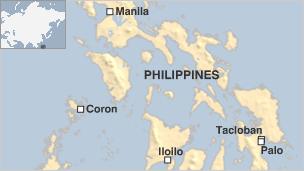
John Andrews, deputy head of the Civil Aviation Authority, said he had been told of more than 100 bodies around Tacloban airport, with at least 100 more people injured.
Airport manager Efren Nagrama said: "It was like a tsunami. We escaped through the windows and I held on to a pole for about an hour as rain, seawater and wind swept through the airport. Some of my staff survived by clinging to trees."
Local TV journalists said they had seen 20 bodies in a church in Palo, 10km (six miles) south of Tacloban.
Sebastian Rhodes Stampa, head of a UN disaster assessment co-ordination team, said there was "destruction on a massive scale" in Tacloban.
"There are cars thrown like tumbleweed and the streets are strewn with debris. The last time I saw something of this scale was in the aftermath of the [2004] Indian Ocean tsunami."
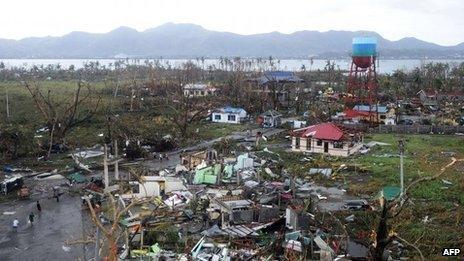
The city of Tacloban was one of the worst-hit areas
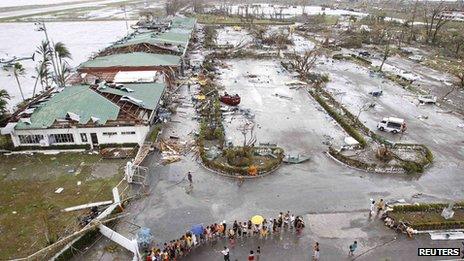
Tacloban residents gathered at the devastated airport for relief supplies
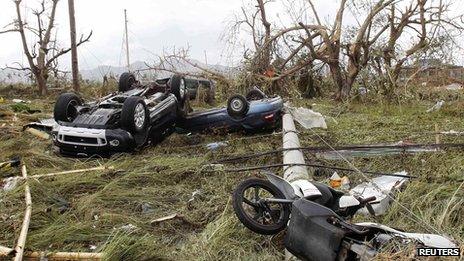
Cars and motorcycles were swept into a rice field
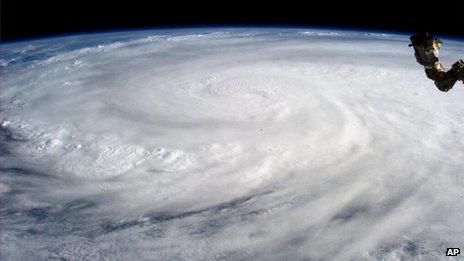
Astronaut Karen Nyberg on the International Space Station took this image of the storm
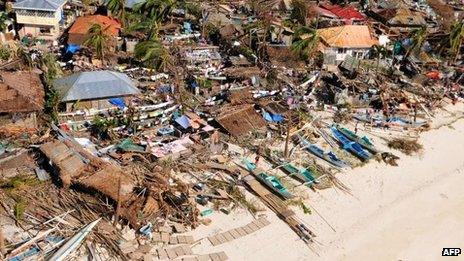
Coastal communities in Iloilo suffered badly in the typhoon
Communications to some of the worst-hit areas were cut off when the storm hit and it may be days before the final death toll and the full extent of the damage is known.
Some 15,000 troops have been deployed to the disaster zones. However, rescuers are struggling to get to remote areas, hampered by debris and damaged roads.
As darkness fell on Saturday, many areas were without electricity.
Jim Pe, deputy mayor of Coron town on the island of Busuanga, said most houses and buildings there had been destroyed or damaged.
Speaking by phone, he said five people drowned in the storm surge and three others were missing.
Haiyan heads to Vietnam
"It was like a 747 [jet] flying just above my roof," he said.
The storm made landfall shortly before dawn on Friday, bringing gusts that reached 379km/h (235 mph), according to the US Navy's Joint Typhoon Warning Center, with waves as high as 15m (45ft), bringing up to 400mm (15.75 inches) of rain in places.
The eye of the storm - known locally as Yolanda - passed well to the south of the capital Manila, but the city still felt its force.
In the typhoon's path were areas already struggling to recover from a deadly 7.3-magnitude earthquake last month, including the island of Bohol, where about 5,000 people are still living in tents.
Britain's ambassador to the Philippines, Asif Ahmad, said on Saturday that a team of humanitarian experts would be sent by the UK "to assess needs and then mobilise resources".
Internet giant Google produced an interactive crisis map, external showing evacuation shelters, command posts and medical centres.
Vietnam evacuation
The typhoon is now heading for Vietnam. Current projections suggest it could move northwards along the coast from Sunday afternoon local time before making landfall south of Hanoi.
The BBC Weather Centre says sustained wind speeds at landfall are currently forecast to be in the region of 120-130 km/h (75-80 mph), with gusts up to 180km/h (115 mph).
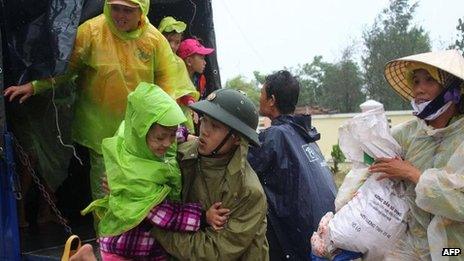
Authorities are evacuating more than 200,000 people in central Vietnam
Authorities there have begun the mass evacuation of more than 200,000 people.
State media report that schools are being closed and people living in low-lying coastal areas are being moved to typhoon shelters on higher ground. Shipping has also been ordered back to port.
Some 170,000 soldiers have been mobilised to provide emergency relief.
Briton Peter Rosenfeld, who is in Da Nang on the coast of central Vietnam, told the BBC he had been evacuated inland with thousands of others and was on the sixth floor of a hotel in the centre.
"The town is now boarded up and the streets are silent... I would be lying if I told you I wasn't frightened," he said.
.gif)
- Published8 November 2013

- Published9 November 2013
- Published8 November 2013
- Published5 July 2023
